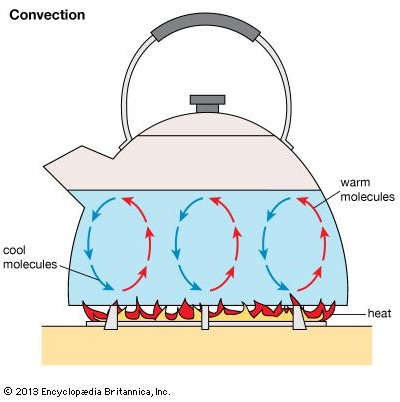Physics 212 Josh Kunz
|
Convection
is
the transfer of thermal energy by the motion
of a fluid.
Water and air are two types of fluids
that
are most often used as examples.
Air/water near the heat source expands
(becomes less dense) and rises,
carrying energy with it. The
more
cold/dense air/water sinks until it reaches
the heat source, absorbs energy and
then rises (Nave 2015). This
rising and
falling of air/water causes a circular flow,
which can be seen in the figure
below. While
this movement is not as
uniform as the figure suggests, it is a good
approximation of the process.
 (http://kids.britannica.com/elementary/art-177312/When-water-is-heated-convection-causes-the-water-at-the)
While
there
is no concrete equation established for
dealing with convective air
movements, the ideal gas law can be used to
understand why the gases/liquids
rise as they increase in temperature.
PV=nRT where P is pressure, V is
volume, n is molar mass, R is the gas
constant, and T is temperature. If
pressure is held constant, an increase in
temperature is an increase in volume,
which decreases density. This
causes
the air/water to rise.
|
|
This site was designed in
compliance to the UAF Physics 212 Section 007 website
project. 04/19/2015 Josh Kunz
Home | Conduction | Convection | Radiation | Bibliography
All Right Reserved © 2006 by bprizze
http://heartlessg.4uhost.info Web Master